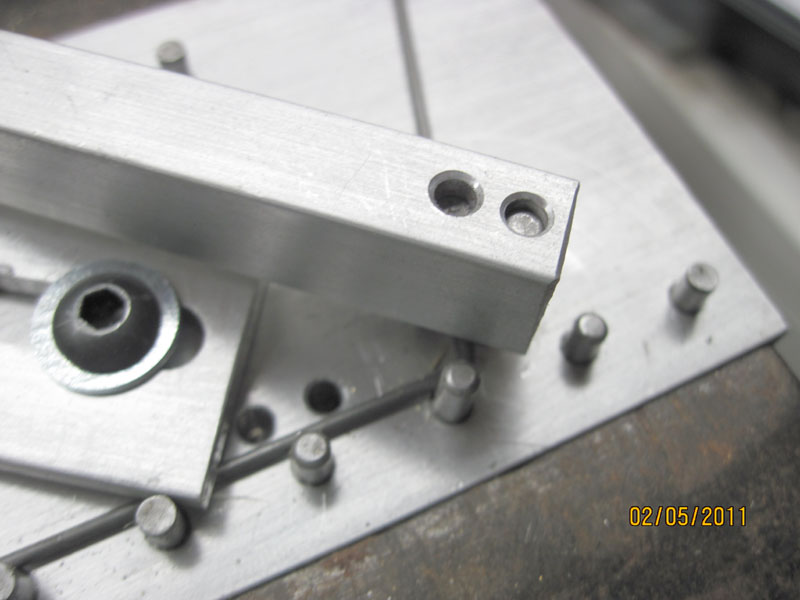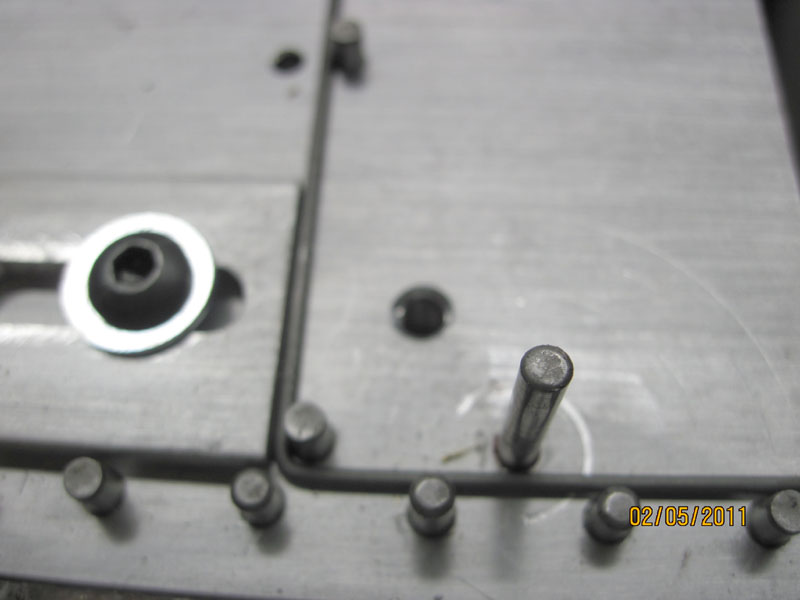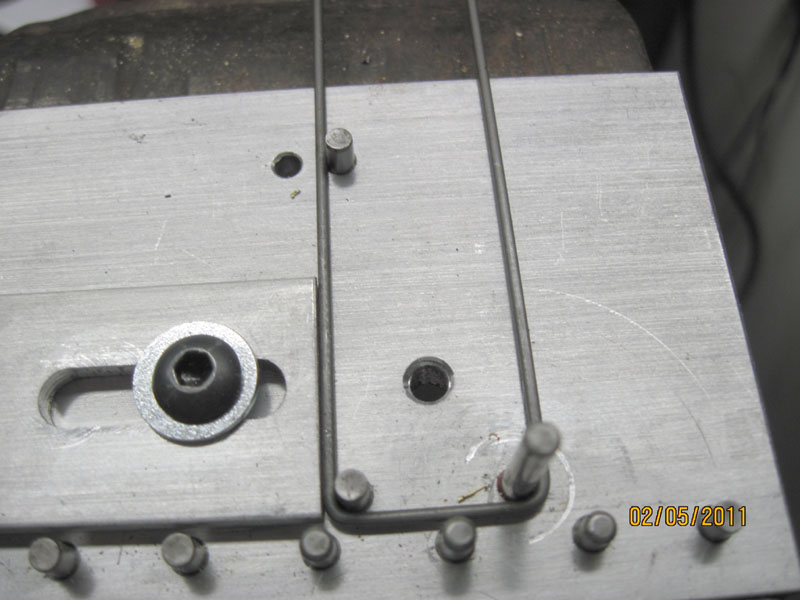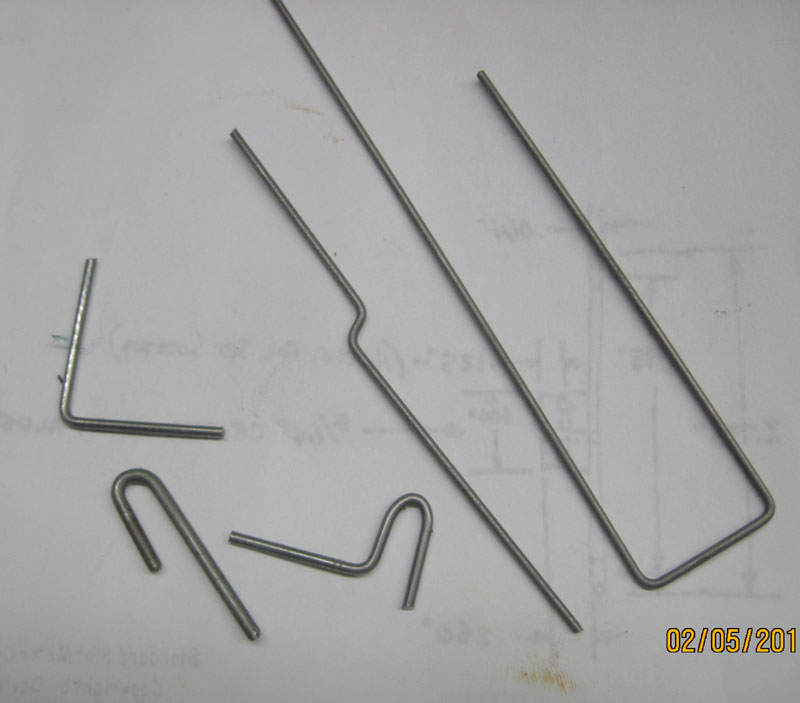There are questions as to how far the wire pulls when you bend it, and how to set the wire for multiple bends etc which are both something you will have to learn on your own through using the little machine. As one of the greatest chassis builders, TonyP, always advised me, one wire, one bend, this way they are always the same and match. You trim each end and make them match. If you chekc out Tony's builds you will notice, in 98% of his builds, he stays with the one wire, one bend format.
A drop of oil on the wire at the pivot point helps reduce frictional drag and pulling.

In this picture just to show the starting position of any wire. Adjust the solid fence to hold the wire diameter against the lower pins. Thisadjustable fence will go from .047" to .078" and even smaller if you tilt the adjustable fence and use the corner to capture .032" and .025" wires. Most wire bending will begin this way.

Slide your beding arm over the pivot post and it should look like this picture. The wire will be between the pivit pin and the bedning pin. Using pins to make the bends helps in reducing micro cracks in the wire.

We have made out first 90 degree bent wire. This is a piece of .062". You will always have to go a little past the scribed line because music wire has a memory. WHen you see how far, you can make a mark on your machine with a sharpie and duplicate this bend over and over. If you would like to make bends over 90 degrees this is also possible, if you want to duplicate a previous wire, just draw a line against the wire on the plate and bend as many as you want.

In this picture I am showing you a loop bend with a piece of .078 wire, just for illustration of the power the little machine gives you. Try to bend this with 2 pair of pliers and you will see what I mean. The wire was captured against the pins and the adjustable fence was moved enough to allow for the full bend.

I have taken the .078" and postioned it to the pivot pin and make a second bend. This is what Marty Stanley used for his pan stops on the Retro Bits Chassis build. This is using .078", just to illustrate. Way overkill for this application and I will show another much simpler version later on.

The etxra heavy duty pan stop.

THis picture is the beginning of a "Z" bend wire, in the event you find you need one. I have bent the wire into the 90 degree position as above. I now have it positioned on the left side of the pivot pin and the adjustable fence holding the wire firmly in place against the pins.

Now place the bending arm and pin on the left side of the wire and bend to the right, opposite of how we have done it to make the 90. Bend the wire until parallel.

This is the result. This is also a piece of 1/16" wire.

Time to make a 3/4" "U" band main rail. as in the above picture, we will bend one "L" bend at 90 degrees. Make certain you leave enough wire for the other side. Once the first 90 is made, we flip the wire over and put the extra pins in the first set of holes(as pictured) and use the adjustable fence to hold this wire tight against these pins. Second bend will be just another 90 and you are done.


Our "U" bend main rails. You can make these .055", .062", or .078" diameter, whatever you want for your build. The next set of holes on the bender will do the same thing but make the "U" bend 1" inside.

This photo is just to show you using the adjustable fence now as a clamp to hold a wire in position for a second bend.

Here is the simple way to make the Marty pan stop. This piece of wire is .047" but you could use .055". I feel .047" is probably enough to do the job. You simply lay the wire up as you would if you wanted to make a simple 90 degree bend, but continue on past the 90 and keep going until you wrap the wire partially around the post and hit the adjustable fence and crank it a little farther and you have a perfect pan stop in one cycle. Cut off excess and solder on the pan in the position to need.

Shapes we have made. I am sure as you use the bender you will come up with more ways/ideas on how you use it and more ways to bend the wire shapes you want. It makes bending the wire rather easy and that is its main function.
If you have any special ways you use the bender, please share them with us. This is the revised bender with the HD bending pivot made from a hardened tool steel pin. The original had a 3/32" pins and a stationary fence. With the pin fence you have more latitude to lower the wire down and in between pins for more creative bending.
I hope this answers some of the questions and helps some out...


























